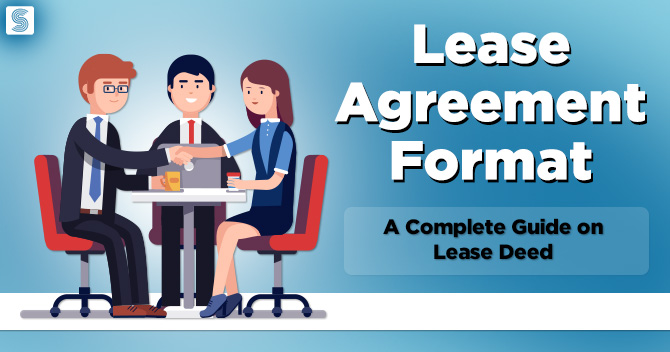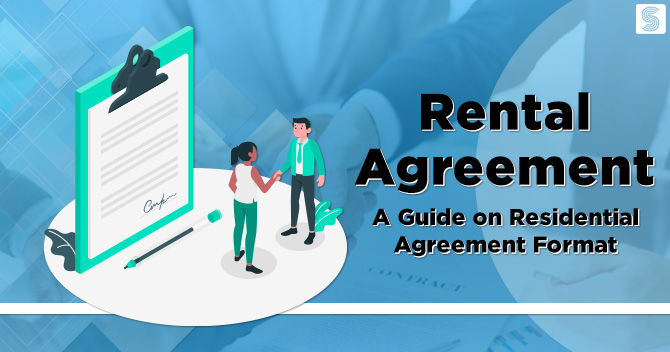Lease Agreement Format: A Complete Guide on Lease Deed

Shivani Jain | Updated: Jun 26, 2020 | Category: Residential Rental Agreement
Usually, people all over the world tend to prefer to own their properties, rather than paying rent for using someone else’s property through a lease. However, leases do offer some key benefits, such as lower risk rate on resale value, tax deductions, low initial payment, and the ease of returning a property without the trouble of reselling it personally. In this learning blog, we will discuss the concept, need, and purpose of the lease along with the Lease Agreement Format.
Table of Contents
Concept of Lease
The Lease is a contractual relationship between landlord and tenants for a fixed tenure. In this relationship, the owner/landlord offers his immovable property [1] to another person for a fixed period and consideration subject to the terms of a lease deed. The lease deed or lease agreement format is the contract which contains duration, monthly rent, and purpose of lease.
In a lease agreement, the owner of the property is known as Lessor, and the tenant is known as Lessee. Further, sections 105 to 117 of the Transfer of Property Act, 1882, acts as the governing law for the concept of a lease. The term“lease” denotes a “Right to Possession” and not a “Right to Ownership”.
Furthermore, after the termination or expiry of the lease period, the parties need to form a new lease agreement format. Therefore, adding a renewal clause does not mean that a lease is renewed. Moreover, if a lessee wants to make any material change in the property, he needs to obtain prior written consent from the lessor.

Key Ingredients of the Definition of Lease
In India, the key ingredients of the definition of Lease can be summarised as:
- Transfer of a Right of Possession on an Immovable Property;
- Right allowed for a certain period of time;
- Both lessor lessee needs to decide the consideration;
- Lessor agrees to transfer his property;
- Lessee agrees to use the property subject to the rules and regulations of the Transfer of Property Act;
- The immovable property given on lease is known as Leased Property.
Essential Terms and Conditions of a Lease
The essential terms and conditions of a lease are as follows:
- Availability of both the Parties: A lease agreement format needs both lessor lessee, i.e., a single party cannot execute or implement a lease deed.
- Parties Competent to Contract: Both the parties to a deed, i.e., lessor and lessee need to be competent as per section 10 of the Indian Contract Act.
- Right to Enjoy the Interest: A lessor cannot restrict the lessee’s enjoyment but putting strict conditions in the contract.
- Right in Rem: The concept of lease always establishes the Right in Rem, i.e., a right is available against the whole.
- Duration of Lease: As per section 106 of the Transfer of Property Act, 1882, a year to year lease will be followed if an immovable property is taken for the agricultural or manufacturing purposes. Whereas, for any other purpose, a month to month lease will be followed by the parties.
- Consideration of Lease: The term “consideration” means a price paid or agreed to be paid as rent. Further, this also includes the monetary value of crops or service.
- Acceptance: Acceptance denotes that both lessor and lessee mutually agree on the terms and conditions of a lease agreement format.
Concept of Lease Agreement Format
A lease agreement format is a contractual arrangement between the lessor and lessee. Through this, the lessor allows the lessee to use of an immovable property owned or overseen by the lessor for a fixed period of time. Further, in exchange for the right to use, the less or charges periodic rental payments.
The lease agreement does not confer ownership rights on the lessee. However, the lessor may permit the lessee to change or modify the property as per his needs. The lessee or tenant is responsible for the good condition of the property throughout the lease period.
Further, a Lease Agreement Format can also be used for the lease of vehicles; properties; construction equipment; household appliances, and other items.
Therefore, a lease agreement acts as a summary of all the terms and conditions of the lease so that each party knows his rights and duties under the lease.
Difference between Lease Agreements and Rental Agreements
The key differences between a Lease Agreement and Rent Agreement can be summarised as:
| Lease Agreements | Rental Agreements |
| A lease agreement is usually made for a longer duration, such as for years. | A Rental Agreement is mostly for a shorter duration, such for some months or a year. |
| The Owner of the property is known as the Lessor. | The Owner of the property is known as the Landlord. |
| The person using the property is known as Lessee. | The person using the property is known as Tenant. |
| Both the Lessor and Lessee cannot change the stipulations of the Lease Agreement Format. | Both Landlord and Tenant are eligible to change the stipulations of the Rental Agreement. |
| The lessee needs to give at least six months’ notice to the lessor before ending the lease. | The tenant needs to give at least 15 to 30 days notice before terminating the rental agreement. |
Essentials of a Valid Lease Agreement Format
The essentials of a valid lease agreement format can be summarised as:
- Duration: The lease deed must clearly specify the tenure for which it will be valid.
- Rent: The payment or the consideration made by the lessee to the lessor in exchange for the use of property leased out is known as rent.
- Security Deposit: The amount paid by the lessee to the lessor in advance is known as the security deposit. Further, the conditions for the adjustment or return of the security deposit is determined at the end of the lease period.
- Terms of Use: The terms of use denote the terms and conditions concerning the use of the immovable property. In a lease deed, the lessor has the right to fix the terms and conditions, which lessee needs to follow.
- Subletting: The lease deed must clearly specify whether the lessee has a right to sublet the property or not.
- Applicable Laws: As per this essential, a lease deed must state the laws which will be relevant over the lessee and lessor in case of any dispute. It must also state the court which will have the jurisdiction and authority to deal with such matters.
- Repairs and Management: The lease deed must clearly specify which party will be responsible for the wear and tear, repairs and maintenance of the property.
Contents of a Lease Agreement Format
The contents of a valid lease agreement can be summarised as:
- Names of both the lessor and lessee;
- Name of the agents of lessor and lessee, if any;
- Description of the immovable property;
- Amount of Rent, Late Charges, Due Dates, and Grace Period;
- Mode of Paying Rent;
- Methods to terminate or end the agreement before the expiry date and charges if any;
- Amount of security deposit along with the account name where it is held;
- Utilities provided by the lessor and, if in case the lesser charges for such facilities, how the charge will be determined;
- Amenities on the premises which the lessee is allowed to use such as laundry, swimming pool, or security systems;
- Rules and Regulations for keeping pet;
- Rules and Regulation for noise level along with the penalty for violation;
- Identification of parking available, comprising of designated parking spaces, if provided;
- Modes of handling tenant repair requests; and
- Procedures for Emergency Requests.
Sample Lease Agreement Format
Sample-LEASE-AGREEMENT-FormatConclusion
A Lease plays a crucial aspect in real life as every person has seen a lease deal relating to renting of a car, property or house. Through the lease, a lessee is given only the possessory rights over the property and not the ownership rights. Further, a lease deed is a basis of governing the contractual relationship of lessor and lessee. The provisions governing the lease are covered under section 105 to 117 of the Transfer of Property Act, 1882.
Also, Read: Know the Basics About Residential Rental Agreements














